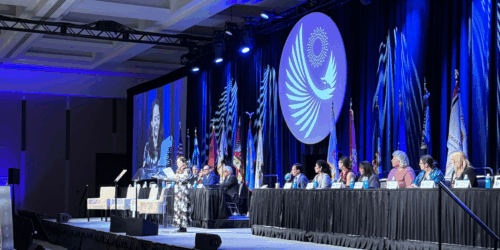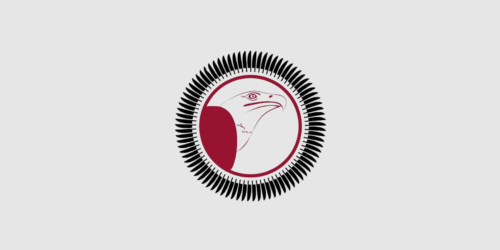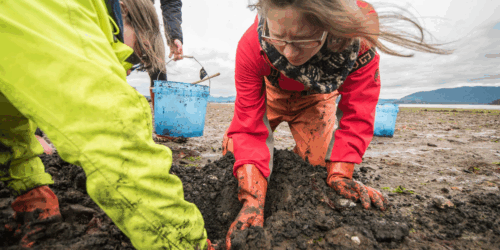CAMBRIDGE, MASS – The Harvard Project on Indigenous Governance and Development’s Honoring Nations program is thrilled to announce the selection of six outstanding tribal programs advancing to the site visit round for the 2025 awards! Selected from an impressive pool of 101 applicants, these six tribal governance programs were selected by an evaluation team consisting of the Honoring Nations Board of Governors and senior staff from both the Harvard Project and the Native Nations Institute. At the heart of Honoring Nations is the belief that tribal nations themselves hold the key to generating social, political, cultural, and economic prosperity and that self-governance plays a crucial role in building and sustaining strong, health Indian nations.
Administered by the Harvard Project on Indigenous Governance and Development at the Harvard Kennedy School, Honoring Nations is a member of a worldwide family of “governmental best practices” awards programs that share a commitment to the core idea that governance can be strengthened by identifying and sharing effective, innovative solutions to common challenges. Throughout a rigorous selection process, applications are evaluated based on their effectiveness, significance to sovereignty, cultural relevance, transferability, and sustainability. Since its founding in 1998, Honoring Nations has recognized 142 outstanding tribal government programs representing over 100 tribal nations across the United States.
Honoring Nation’s Director, Megan Minoka Hill (Oneida Nation WI) explains, “All governments, Native and non-Native can gain valuable insights from the innovative and effective ways tribal nations are addressing universal challenges and creating solutions that serve not only their citizens but also broader regions.”
From advancing environmental stewardship to pioneering health care models and education systems rooted in cultural values, tribal nations are demonstrating scalable, culturally informed approaches to governance. The upcoming site visits this summer provide a unique opportunity to witness firsthand the impact of the programs on the ground—offering a deeper understanding of how Indigenous governance is driving meaningful change and delivering results that resonate far beyond tribal boundaries.
“We are grateful for the opportunity to explore their work more deeply and share lessons that can inform and inspire governments throughout Indian Country and around the world,” says Jael Whitney Brothers (Choctaw), Assistant Director of Honoring Nations. The six programs are:
- Bears Ears Inter-Tribal Coalition – Intertribal
- In response to increasing political and environmental challenges, leaders from the Hopi Tribe, Navajo Nation, Ute Mountain Ute Tribe, Pueblo of Zuni, and Ute Indian Tribe founded the Bears Ears Inter-Tribal Coalition in July 2015 to protect their ancestral lands. Guided by their right to self-determination and rooted in Indigenous knowledge and conservation practices, they collaboratively develop and implement land management plans for over 1.9 million acres. The Coalition also continues to exercise their political sovereignty in their advocacy for Bears Ears National Monument and practice of Traditional Ecological Knowledge to improve management of this sacred place in a manner that promotes its sustainability for all to enjoy.
- The College of Osteopathic Medicine at the Cherokee Nation – Cherokee Nation
- In a historic demonstration of tribal sovereignty in healthcare and education, the Cherokee Nation partnered with Oklahoma State University Center for Health Sciences to establish the nation’s only tribally affiliated medical school. Approximately 20% of the medical students are tribal citizens, many of whom remain in Oklahoma after graduation. By focusing on culturally competent care, College of Osteopathic Medicine at the Cherokee Nation seeks to reduce health disparities and improve health outcomes in tribal and rural communities by ensuring that medical students are trained for primary care residencies at tribal facilities and for successful practices in tribal, rural, and underserved communities.
- Iron Horse Industrial Park – Citizen Potawatomi Nation
- Expanding its capacity for economic development and sustainable resource management, the Citizen Potawatomi Nation established Iron Horse, a 700-acre eco-industrial park on their trust land in east-central Oklahoma. This tribally owned and governed park emphasizes environmental sustainability while expanding the Nation’s economic base, operating as a magnet site within Foreign Trade Zone 106 as one of the first Foreign Trade Zones on Native American land with active sites, reflecting their drive for economic self-determination.
- Jicarilla Apache Nation’s Water Sharing Agreement – Jicarilla Apache Nation
- The Jicarilla Apache Nation and the New Mexico Interstate Stream Commission have worked together on a government-to-government basis with support from the Nature Conservancy to develop a first-of-its-kind water lease agreement between a state, tribe, and conservation non-profit. This agreement allows the Nation to lease up to 200,000 acre-feet of water to New Mexico’s Strategic Water Reserve over 10 years, enhancing water security for the state, providing ecological benefits for the San Juan River, and affirming Jicarilla Apache’s inherent rights over its natural resources.
- Sche’lang’en Village Transformational Wrap-Around Program – Lummi Nation
- The Sche’lang’en Village is a gated, clean and sober Salish community designed to safely reunite parents with their children who had been removed by Indian Child Welfare and/or Child Protective Services. Providing comprehensive wraparound services, including mental health, chemical dependency, family counseling, parenting services, and other special medical needs, the program has become a hub of resources from tribal departments across the Nation, streamlining services and empowering families.
- Taos Pueblo Priority Process – Taos Pueblo
- To promote the principles of self-determination and self-governance among their citizens, Taos Pueblo established the Taos Pueblo Priority Process, a community-driven initiative that utilizes participatory workshops to define community priorities in alignment with cultural practices which are implemented in tribal programming and policies. This process has led to new laws, leadership changes, and increased engagement in tribal-wide priorities, reflecting the Pueblo’s inherent right to shape its own future.
Awards will be made in a ceremony held in conjunction with the National Congress of American Indians’ conference to be held in November 2025.
We are grateful to have learned about the Honoring Nations 2025 semifinalists who did not advance to the site visit round. Their work serving their nations and citizens is both inspiring and impactful, offering valuable lessons for governments everywhere.
- Career Pathways – Gila River Indian Community
- To address a gap in their community between existing employment opportunities and citizens who have the necessary skills to fill those positions, the Gila River Indian Community created the first-ever Native American Career Pathways workforce development model in Indian Country. This model connects community members with the local labor market where employers create and lead their own occupational training programs, resulting in meaningful employment, improved job skills, and increased hiring rates within the Community.
- Citizen Potawatomi Nation Eagle Aviary – Citizen Potawatomi Nation
- Exercising its sovereign right to preserve cultural heritage and manage natural resources, the Citizen Potawatomi Nation Eagle Aviary provides a permanent sanctuary for injured eagles and other raptors unable to return to the wild that would otherwise be euthanized for lack of placement in other long-term facilities. The Aviary has filled over 1000 applications for eagle feathers and provided hundreds more for naming and other ceremonies, for their tribal youth programs, as well as their Department of Education, and Recovery and Reintroduction programs.
- Community Wildfire Protection Plan Goat Fire Fuel Mitigation Program – The Yuhaaviatam of San Manuel Nation
- The Yuhaaviatam of San Manuel Nation developed the Community Wildlife Protection Plan Goat Fire Fuel Mitigation Program to address complex wildfires in their community in a way that integrates tribal values into the management of natural and cultural resources. Utilizing Traditional Ecological Knowledge and exercising its inherent authority over land management, the Nation employs goats for vegetation control, reducing wildfire risk on their reservation and surrounding communities while upholding their culturally informed stewardship principles.
- Five Tribe Wildlife Management Reciprocity Agreement – Intertribal
- Through an intertribal government-to-government agreement, the Cherokee Nation, Chickasaw Nation, Choctaw Nation of Oklahoma, Muscogee Nation, and Seminole Nation have established the Five Tribe Wildlife Management Reciprocity Agreement. This agreement recognizes the rights of each member tribe to manage natural resources in accordance with their own laws and traditions, provides a process for effective intergovernmental collaboration, and expands citizen hunting and fishing access across the five tribal reservation boundaries.
- Fond du Lac Land Information Department – Fond du Lac Band of Lake Superior Chippewa
- The Fond du Lac Band of Lake Superior Chippewa operates the Land Information Department to support tribal sovereignty over their land and resources by overseeing the legal aspects of land management as well as digital land data. The department administers critical information and processes related to land ownership, usage, rights-of-way, leasing, probates, fractional land interest acquisition, and fee-to-trust applications. They also maintain essential GIS mapping software for their Natural Resources division and a publicly accessible webmap, demonstrating their commitment to self-determination in land management.
- Grey Snow Eagle House – Iowa Tribe of Oklahoma
- The Iowa Tribe of Oklahoma’s Grey Snow Eagle House is a leader in eagle conservation, bridging Western and Indigenous scientific practices and institutions through four core programs: long-term care for permanently injured eagles, rehabilitation of injured eagles, outreach education, and cutting-edge genetic research, including five published scientific articles to date. The Grey Snow Eagle House is guided by tribal core values to ensure the preservation of this sacred species for future generations.
- Inter-Tribal Indigenous Marine Stewardship Area Initiative – Intertribal
- Recognizing and asserting their responsibility for protecting marine resources, the Yurok-Tolowa Dee-ni’ tribes have collaboratively established the first tribally designated marine stewardship area in the United States. Through an Inter-Tribal Indigenous Marine Area Advisory Council, these sovereign nations coordinate their efforts to protect and restore vital marine ecosystems, species, and cultural practices, upholding their shared and individual stewardship responsibilities in accordance with their self-determination.
- Lower Sioux Community Industrial Hemp Housing Program – Lower Sioux Indian Community
- The Lower Sioux Community Industrial Hemp Housing Program proactively constructs healthy housing, creates employment opportunities, fosters environmental stewardship, and strengthens tribal sovereignty for the Sioux Indian Community. The program grows hemp and processes it into hempcrete, a sustainable building material, as well as trains and employs tribal citizens in the construction and retrofitting of homes on their reservation, demonstrating their commitment to providing both housing and economic development to the nation and its citizens.
- MHA Emergency Operations Center – Mandan, Hidatsa, and Arikara Nation
- Actively building institutions and infrastructure to provide for the safety and well-being of its citizens, the Mandan, Hidatsa, and Arikara Nation operate the MHA Emergency Operations Center. This tribally directed center develops and maintains a comprehensive framework to reduce vulnerabilities on the Ft. Berthold Reservation by coordinating all necessary activities to mitigate, prepare for, respond to, and recover from disasters, affirming their sovereign authority in emergency management.
- Mother Town Healing Program – Eastern Band of Cherokee Indians
- To support the health and well-being of its citizens in recovery, the Eastern Band of Cherokee Indians established the Mother Town Healing Program. This tribally led initiative assists tribally enrolled citizens in recovery by providing a supportive work environment, job skills training, and structure for reintegration into the workforce, while also encouraging the rebuilding of community connections, reflecting the tribe’s self-determination in addressing social and health issues.
- Northwest Indian Treatment Center – Squaxin Island Tribe
- The Squaxin Island Tribe established the Northwest Indian Treatment Center in 1994 to use immersive, culturally adapted best practices to treat chronic substance abuse and relapse patterns for citizens of 40+ tribes across the region. Of the clients who graduate from the treatment center, approximately 86% have consistently self-reported sobriety and/or reduced substance use during the year after treatment, which is over double the average rate of residential treatment throughout the US.
- Snoqualmie Tribe’s Lands Protection Tax – Snoqualmie Indian Tribe
- The Snoqualmie Falls are central to the history, spiritual practice, and identity of the Snoqualmie people. To protect this region and provide critical resources, the Snoqualmie Tribe implemented a groundbreaking 2% Lands Protection Tax on sales at the tribally owned Salish Lodge & Spa. These revenues are used for projects and expenses related to the tribal government’s work to safeguarding their ancestral territories in and around Snoqualmie Falls, demonstrating their fiscal sovereignty and commitment to land preservation.
###
About the Project on Indigenous Governance and Development
The Project on Indigenous Governance and Development (formerly the Harvard Project on American Indian Economic Development) is based in the Ash Center for Democratic Governance and Innovation at the John F. Kennedy School of Government, Harvard University. Through applied research and service, the Project aims to understand and foster the conditions under which sustained, self-determined social and economic development is achieved among American Indian nations. The Project’s core activities include research, education, and the administration of Honoring Nations, a tribal governance awards program. In all of its activities, the Project collaborates with the Native Nations Institute for Leadership, Management, and Policy at the University of Arizona. The Project is also formally affiliated with the Harvard University Native American Program, an interfaculty initiative at Harvard University.
For more information about Honoring Nations, please visit the Project’s website at www.IndigenousGov.hks.harvard.edu or email IndigenousGov@hks.harvard.edu.
About the Ash Center for Democratic Governance and Innovation
The Ash Center for Democratic Governance and Innovation at Harvard Kennedy School advances excellence in governance and strengthens democratic institutions worldwide. Through its research, education, international programs, and government innovations awards, the Center fosters creative and effective government problem solving and serves as a catalyst for addressing many of the most pressing needs of the world’s citizens.
Contact Information
Melissa Yazzie
Project on Indigenous Governance and Development
melissa_yazzie@hks.harvard.edu
Courtney DeJesus
Ash Center for Democratic Governance and Innovation
courtneycarterdejesus@hks.harvard.edu





